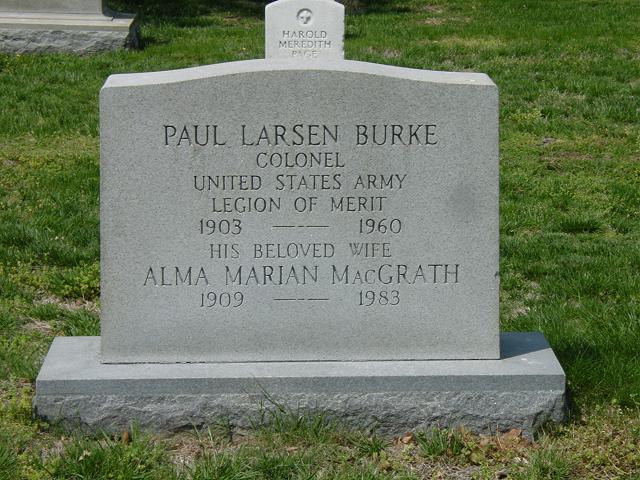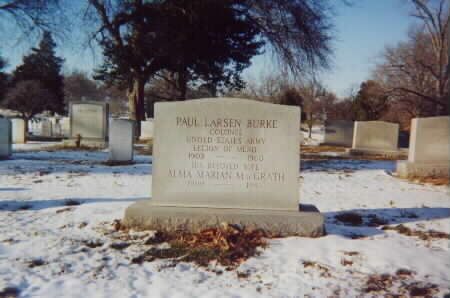Courtesy of Barbara Burke Berntsen:
Paul Larsen Burke was born in Newark, New Jersey on June 4, 1903. He attended Newark schools. In 1921, at the age of 18, Paul enlisted as a Private in the New Jersey National Guard’s Essex Troop. By 1930, he attained the rank of Second Lieutenant after attending the Officers Candidate School at Fort Riley, Kansas. Since the National Guard work was not full time, Paul also worked as a Building Manager in New York City and attended Columbia University. On September 26, 1934, he married the former Alma M. MacGrath of East Orange, New Jersey at a small church in New York City. Together they had three children, Barbara, 1937, Paul J., 1938 and Donald, 1940.
When the Essex Troop mobilized in 1941, Major Paul L. Burke applied to the War Dept for a regular commission and was turned down. But he persisted and was rewarded with a commission as a Reserve Officer on Active Duty with the 102nd Cavalry Regiment (Mechanized) and became its Executive Officer.
Travelling with the Regiment to Fort Jackson, South Carolina in 1941 for training in the mechanized aspects of the Regiment occurred next. After the bombing of Pearl Harbor, on December 7, 1941, Colonel Burke returned to New Jersey with the Regiment for prepare for overseas training in England. On September 6, 1942, he left the United States with the Regiment aboard the Dutch transport ship, DEMPO, and travelled to England, arriving in Liverpool on October 6, 1942. While in England, Colonel Burke attended the Senior Officers School and continued to supervise the Group’s daily activities.
On January 2, 1944, the Regiment was reclassified as a Group, consisting of Headquarters Troop, a Medical Detachment and the 102nd Cavalry Reconnaissance Squadron.
The Group was attached to V Corps shortly before the D-Day invasion on June 6, 1944. The Group (Headquarters Troop and 102nd Cavalry Reconnaissance Squadron) boarded four ships on June 4 and sailed from Falmouth, England on June 6 arriving off the coast of France on June 7, 1944. The first elements of the Group remained aboard ship for one day and observed the invasion activities. Finally, the word was given and these first elements of the Group advanced in three LST’s to the French soil on June 8, 1944. The Group was credited for being among the D-Day invasion assault forces. The remainder of the Group (the 38th Cavalry Reconnaissance Squadron) did not land until June 13, 1944.
One of the Group’s major achievements during World War II was the invention of the hedgerow cutter, which was adopted by every Armored unit then in France and significantly aided the breakthrough at St. Lo.
On August 3, Lieutanan Colonel Burke, with approximately twenty-five men, was proceeding toward the Vire River on a road reportedly clear of the enemy, when the head of his column was halted by an enemy mine field covered by small arms and anti-tank fire. In spite of the fact that the enemy, in undetermined numbers, manned defensive positions only one hundred yards away, Colonel Burke went forward, without regard for his personal safety, to make a personal reconnaissance of the mine field. He then dispersed his column, set up a command post in a farm just off the road, and deployed the leading squadron in an attack on the enemy positions. Though his command post became the focal point for the fire of an enemy anti-tank gun and two enemy self-propelled large caliber guns and sustained some casualties, he remained at a post outside a command
half-track to issue the necessary radio orders and supervise all phases of the operation, averting a heavy loss of men and vehicles. For this action he was awarded the Bronze Star.
The 102nd Cavalry Group was the first American unit to enter Paris on August 25, 1944. It also prevented the Germans from advancing to Liege at the northern end of the Ardennes conflict and provided the security for the American Generals of V Corps and the 69th Infantry Division in their meeting with the Russians at Torgau.
In 1945, following the termination of the war in Europe, Colonel Burke was transferred to The Cavalry School in Fort Riley, Kansas where he served as instructor in the Department of Tactics. In 1947, he was promoted to the rank of Colonel, Cavalry. He participated in The Cavalry School Hunt where he was given the status of Honorary Whipper-In.
In 1950, he graduated from the Command and General Staff College at Fort Leavenworth, Kansas. Also in 1950, Colonel Burke was reassigned to the Kitzingen, Germany subpost as the Assistant Commanding Officer. In 1951, Colonel Burke was transferred to Wuerzburg to be the Commanding Officer of the Wuerzburg Municipal Subpost.
Virginia was his next assignment. In 1953, Colonel Burke was served as the Chief of Staff at Camp Pickett. The following year, he assumed command of Camp A. P. Hill, where he was responsible for providing administrative and logistical support to the Army units, Active and Reserve, who utilized the base for maneuvers and field training exercises. He served there as Commanding Officer until his retirement in 1959.
Colonel Burke died in 1960 from the effects of Lou Gehrig’s disease. He is buried with his wife in Arlington National Cemetery in Grave No. 5260 LH, Section 8 between Jesup Drive and Patton Drive.
Colonel Burke’s World War II decorations include the Legion of Merit, the Bronze Star with two Oak Leaf Clusters, the Luxembourg Croix de Guerre
and the Czechoslovakian War Cross. He also authored two articles which appeared in The Cavalry Journal, to wit:
Employment of Cavalry Assault Guns, November/December 1944 and Patrolling the Siegfried, May/June 1945.
Survivors include two sons, Paul James Burke and Donald Lawrence Burke, Aeronautical Engineers; one daughter, Barbara Burke Berntsen, Computer Systems Specialist, and one grandson: Second Lieutenant Andrew M. Berntsen, United States Marine Corps Aviation.

Michael Robert Patterson was born in Arlington and is the son of a former officer of the US Army. So it was no wonder that sooner or later his interests drew him to American history and especially to American military history. Many of his articles can be found on renowned portals like the New York Times, Washingtonpost or Wikipedia.
Reviewed by: Michael Howard

